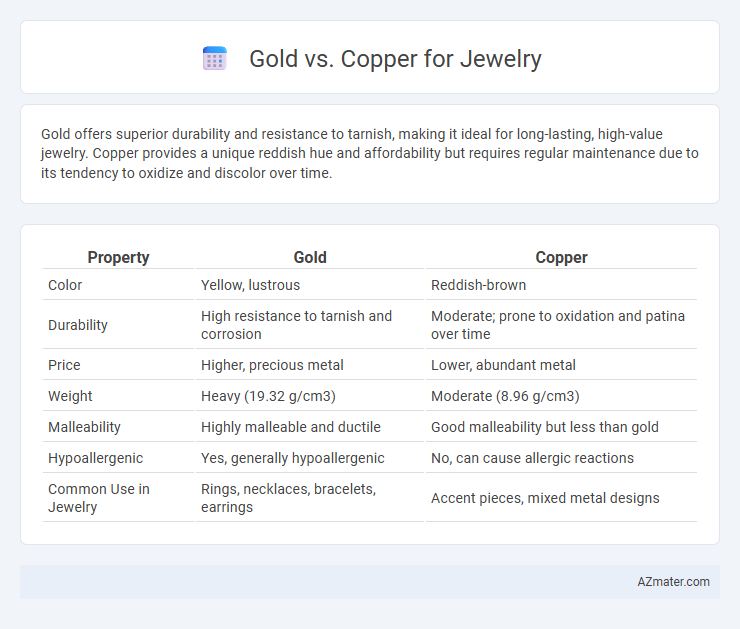Gold offers superior durability and resistance to tarnish, making it ideal for long-lasting, high-value jewelry. Copper provides a unique reddish hue and affordability but requires regular maintenance due to its tendency to oxidize and discolor over time.
Table of Comparison
| Property | Gold | Copper |
|---|---|---|
| Color | Yellow, lustrous | Reddish-brown |
| Durability | High resistance to tarnish and corrosion | Moderate; prone to oxidation and patina over time |
| Price | Higher, precious metal | Lower, abundant metal |
| Weight | Heavy (19.32 g/cm3) | Moderate (8.96 g/cm3) |
| Malleability | Highly malleable and ductile | Good malleability but less than gold |
| Hypoallergenic | Yes, generally hypoallergenic | No, can cause allergic reactions |
| Common Use in Jewelry | Rings, necklaces, bracelets, earrings | Accent pieces, mixed metal designs |
Gold vs Copper: Overview and Popularity
Gold jewelry remains highly popular due to its durability, timeless appeal, and hypoallergenic properties, making it a preferred choice for engagement rings and luxury accessories. Copper, while less expensive and valued for its warm reddish hue and antimicrobial benefits, is more prone to tarnishing and requires regular maintenance to retain its appearance. The demand for gold consistently surpasses copper in the jewelry market, driven by its cultural significance and widespread consumer preference.
Chemical Properties and Durability
Gold exhibits exceptional chemical stability, resisting tarnish and corrosion due to its inertness, which makes it ideal for long-lasting jewelry. Copper, while more reactive and prone to oxidation, develops a characteristic patina over time that can enhance aesthetic appeal but requires maintenance to prevent verdigris. The superior durability and resistance to environmental damage make gold a preferred choice for fine jewelry, whereas copper offers affordability and unique aging qualities.
Color and Aesthetic Appeal
Gold offers a rich, warm yellow hue that exudes luxury and classic elegance, making it a timeless choice for jewelry. Copper, with its distinctive reddish-orange tone, provides a unique, rustic charm that appeals to those seeking an earthy and vintage aesthetic. Both metals develop patinas over time, with gold maintaining its luster and copper deepening in color, enhancing their respective visual appeal.
Hypoallergenic Qualities
Gold, particularly 14k and 18k varieties, is renowned for its hypoallergenic properties due to its high purity and minimal alloy content, making it ideal for sensitive skin. Copper, while valued for its unique reddish hue and affordability, often causes allergic reactions owing to its high alloy additives and tendency to oxidize, leading to skin irritation or discoloration. Choosing gold jewelry significantly reduces the risk of contact dermatitis and other allergic responses compared to copper-based pieces.
Price Comparison and Affordability
Gold jewelry commands a higher price due to its rarity, purity, and demand, often priced several times above copper pieces. Copper offers an affordable alternative with its lower market value and durable qualities, making it accessible for budget-conscious consumers. Price fluctuations in gold are influenced by global economic trends and investment demand, while copper prices remain relatively stable, enhancing its affordability for everyday jewelry.
Ease of Maintenance and Tarnish Resistance
Gold jewelry offers superior ease of maintenance due to its natural resistance to tarnish and corrosion, requiring minimal cleaning to retain its luster. Copper, while popular for its warm hue, tends to oxidize and develop a patina over time, demanding more frequent polishing to maintain its shine. The durability and low reactivity of gold make it a preferable choice for jewelry that needs less upkeep and long-lasting brilliance.
Craftsmanship and Workability
Gold's malleability and ductility make it a preferred choice for intricate jewelry designs requiring detailed craftsmanship, allowing artisans to achieve fine, precise work without compromising durability. Copper, while less malleable, offers excellent workability for sturdy and rustic jewelry styles, often used in combination with other metals to enhance strength and create unique textures. The inherent softness of pure gold demands careful handling during creation, whereas copper's hardness supports robust shaping techniques, making both metals valuable depending on the artistic intent and design complexity.
Environmental Impact and Ethical Sourcing
Gold mining generates significant environmental impacts including habitat destruction, water pollution, and high energy consumption, often exacerbated by large-scale operations. Copper extraction, while also environmentally demanding, typically has a lower carbon footprint and less toxic waste compared to gold mining. Ethical sourcing practices for both metals are crucial, with certified Fairtrade gold and recycled copper offering more sustainable and socially responsible options for jewelry makers.
Suitability for Everyday Wear
Gold is highly suitable for everyday wear due to its resistance to tarnish and corrosion, maintaining its luster over time with minimal maintenance. Copper, while visually appealing with its warm reddish hue, tends to oxidize and develop a green patina, requiring frequent cleaning to preserve its appearance. For durability and hypoallergenic properties, gold alloys such as 14k or 18k are preferred choices for daily jewelry use.
Investment Value and Resale Potential
Gold holds a higher investment value than copper due to its rarity, intrinsic value, and widespread global demand in jewelry and finance markets. Copper, while more affordable and popular for its unique aesthetic, lacks the same long-term resale potential because it is more abundant and less valued historically as a precious metal. Investors typically prefer gold jewelry for preserving wealth and capital appreciation, whereas copper jewelry serves more as a fashion choice with limited financial returns.

Infographic: Gold vs Copper for Jewelry
 azmater.com
azmater.com